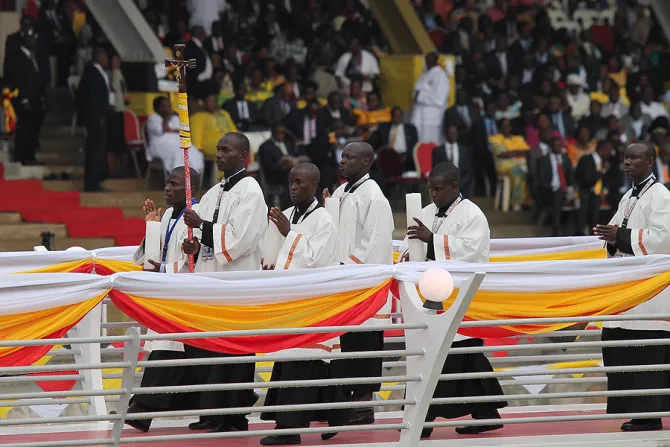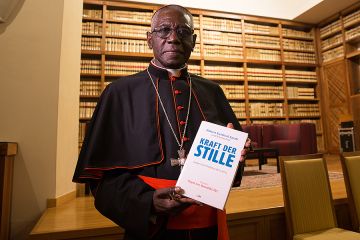Kampala, Uganda, Feb 3, 2020 / 12:01 pm
The Archbishop of Kampala issued a decree Saturday on the proper celebration of the Eucharist, which forbade the reception of Holy Communion in the hand and reaffirmed that those "living in illicit marital co-habitation" cannot be admitted to Holy Communion.
The Feb. 1 decree of Archbishop Cyprian Lwanga included five norms "meant to streamline the celebration of the Holy Eucharist, and curb the abuses that had begun cropping up in the celebration of the Mass."
The archbishop added that he was issuing the norms "relying on the Liturgical and canonical norms of the Church Universal and basing on the vigilance which is required of him by law to fend off abuses in the liturgical life of the Church."
Archbishop Lwanga wrote that "Henceforth, it is forbidden to distribute or to receive Holy Communion in the hands," adding that the Code of Canon Law enjoins that the Eucharist be held in the highest honor by the faithful.
"Due to many reported instances of dishonoring the Eucharist that have been associated with reception of the Eucharist in the hands, it is fitting to return to the more reverent method of receiving the Eucharist on the tongue," he stated.
It is unclear whether reception of the Eucharist in the hand has been formally permitted in Uganda, or has existed as a custom.
The ordinary then recalled that the ordinary minister of Holy Communion is a cleric. "In light of this norm," he wrote, laity who have not been designated extraordinary minister of Holy Communion by competent authority are forbidden from distributing Holy Communion. He added that extraordinary ministers must first receive Holy Communion from an ordinary minister before distributing it in turn.
Archbishop Lwanga wrote that "The celebration of the Eucharist is to be carried out in a sacred place unless grave necessity requires otherwise," citing canon 932, which refers to necessity.
Following that canon, he said, "the Eucharist is henceforth to be celebrated in designated sacred places since there is an adequate number of such designated places in the Archdiocese for that purpose."
"Following the clear norms of Can. 915, it must be reaffirmed that those living in illicit marital co-habitation and those who persist in any grave and manifest sin, cannot be admitted to Holy Communion," the archbishop wrote.
Illicit marital co-habitation could refer to a variety of situations, including divorce-and-remarriage, simple cohabitation, concubinage, and polygamy.
The archbishop added that "so as to avoid scandal" Mass may not be said "in the homes of people in such a situation."
Finally, Archbishop Lwanga noted that the Code of Canon Law says priests and deacons are to wear the vestments prescribed by the rubrics, and in light of this he said, "it is strictly forbidden to admit as a concelebrant, any priest who is not properly vested in the prescribed liturgical vestments."
"Such a priest should neither concelebrate nor assist at the distribution of Holy Communion," he wrote. "He should also not sit in the sanctuary but rather take his seat among the faithful in the congregation."
In 1969, five years after the conclusion of the Second Vatican Council, the Congregation for Divine Worship issued an instruction which expressed that Blessed Paul VI had determined not to change the means of administering Holy Communion to the faithful – i.e., to retain distribution of the Host on the tongue to those kneeling, rather than allowing communicants to receive the Host in their hands.
The instruction, Memoriale Domini, indicated that where distribution of Communion in the hand already prevailed, episcopal conferences should weigh carefully whether special circumstances warranted reception of the Eucharist in the hand, avoiding disrespect or false opinions regarding the Eucharist and ill effects that might follow, and if a two-thirds voting majority decided in the affirmative, such a decision could be affirmed by the Holy See.
(Story continues below)
It noted that "It is certainly true that ancient usage once allowed the faithful to take this divine food in their hands and to place it in their mouths themselves."
But "Later, with a deepening understanding of the truth of the eucharistic mystery, of its power and of the presence of Christ in it, there came a greater feeling of reverence towards this sacrament and a deeper humility was felt to be demanded when receiving it. Thus the custom was established of the minister placing a particle of consecrated bread on the tongue of the communicant."
"This method of distributing holy communion must be retained … not merely because it has many centuries of-tradition behind it, but especially because it expresses the faithful's reverence for the Eucharist."
The congregation also wrote that this traditional practice "ensures, more effectively, that holy communion is distributed with the proper respect, decorum and dignity. It removes the danger of profanation of the sacred species" and "it ensures that diligent carefulness about the fragments of consecrated bread which the Church has always recommended."
They noted that "A change in a matter of such moment … does not merely affect discipline. It carries certain dangers with it which may arise from the new manner of administering holy communion: the danger of a loss of reverence for the august sacrament of the altar, of profanation, of adulterating the true doctrine."
When some bishops asked for permission for Communion in the hand, Bl. Paul VI sought the opinion of all the Church's Roman rite bishops. Of those responding, 57 percent said that attention should not be paid to the desire for the reception of Communion on the hand. Of those bishops who were open to considering the practice, just over one-third had reservations about it.
And 60 percent of bishops did not even wish that Communion in the hand be experimented with in small communities. More than half did not believe the faithful would receive such a change gladly.
So, in 1969, Bl. Paul VI "decided not to change the existing way of administering holy communion to the faithful," considering the remarks and advice of his fellow bishops, the gravity of the matter, and the force of the arguments against it.
Despite this instruction, and subsequent expressions of support for the reception of Holy Communion on the tongue from St. John Paul II and Benedict XVI, the distribution of the Eucharist on the hand has become widely adopted, especially in the West.
The Congregation for Divine Worship's 2004 instruction on matters regarding the Eucharist, Redemptionis sacramentum, established that: "Although each of the faithful always has the right to receive Holy Communion on the tongue, at his choice, if any communicant should wish to receive the Sacrament in the hand, in areas where the Bishops' Conference with the recognitio of the Apostolic See has given permission, the sacred host is to be administered to him or her. However, special care should be taken to ensure that the host is consumed by the communicant in the presence of the minister, so that no one goes away carrying the Eucharistic species in his hand. If there is a risk of profanation, then Holy Communion should not be given in the hand to the faithful."
In the US, the General Instruction of the Roman Missal states that "The consecrated host may be received either on the tongue or in the hand, at the discretion of each communicant."



